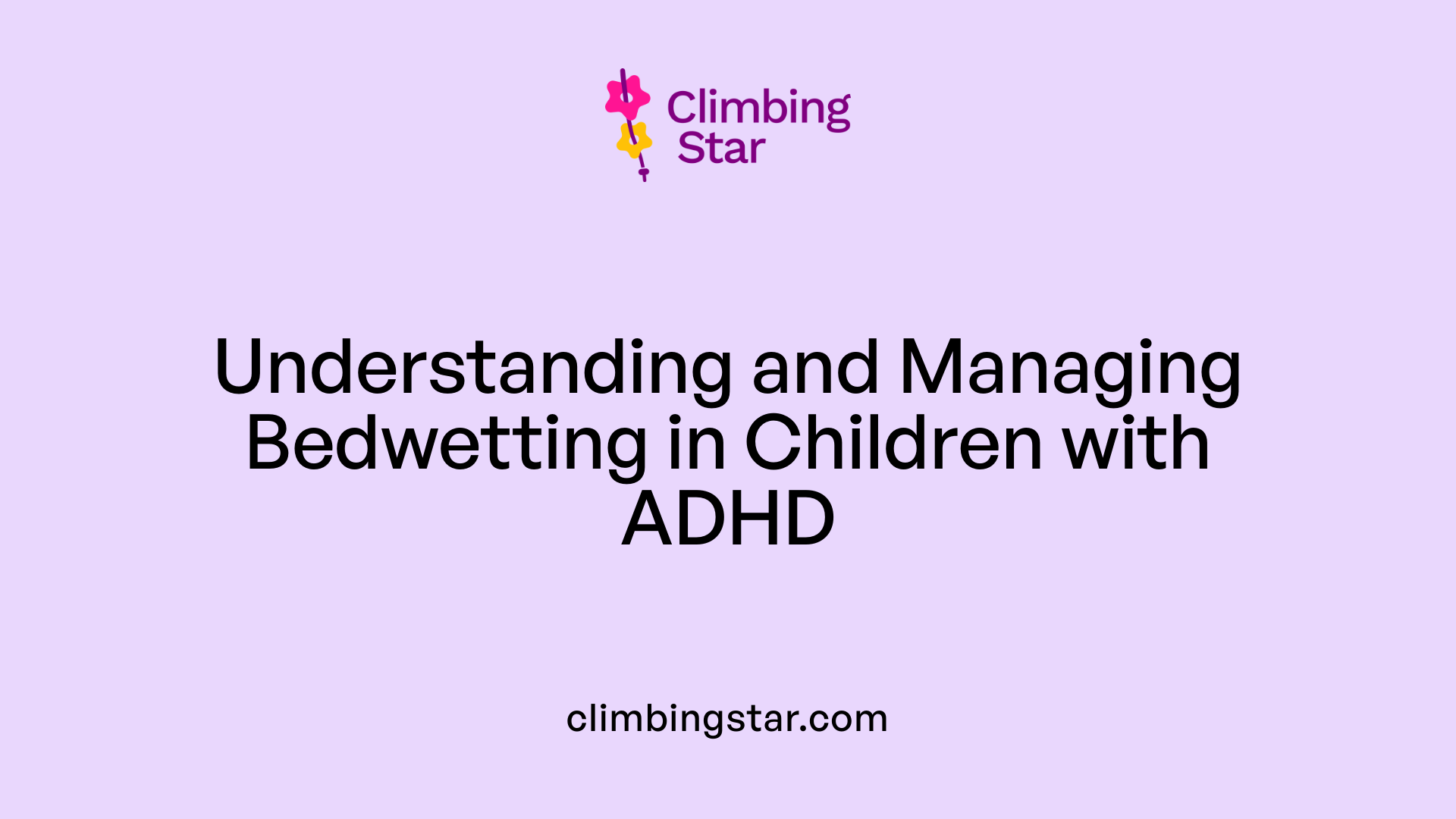Exploring the Challenges and Solutions for Bedwetting in Autism
Bedwetting, or nocturnal enuresis, is a common challenge faced by many children, but those with autism spectrum disorder (ASD) often experience it at higher rates. This article delves into the unique factors that contribute to bedwetting among autistic children and explores effective strategies, including behavioral therapies and environmental adaptations, that promote better management and support for these children and their families.
The Link Between Autism and Bedwetting: Causes and Challenges
Prevalence of Bedwetting in Children with Autism
Children with autism are more likely to experience bedwetting compared to typically developing children. This heightened prevalence reflects the complex interplay of neurological and behavioral factors associated with autism.
Sensory Sensitivities and Communication Difficulties
Sensory sensitivities common in autism can make children less aware of the sensation to urinate. Communication challenges may also hinder their ability to express the need to use the bathroom during the night. These issues combine to increase the risk of bedwetting.
Disrupted Sleep Patterns
Sleep disturbances, frequent in many children with autism, contribute to bedwetting. Disrupted sleep can delay or prevent full awakening when the bladder is full, reducing the child’s ability to respond to nighttime urges.
Impact on Emotional Well-Being and Family Dynamics
Bedwetting affects more than physical comfort; it can cause significant emotional distress. Children may experience anxiety, lowered self-esteem, and shame, while families may face added stress. Supportive, patient approaches emphasizing reassurance over punishment are crucial to help children cope with these challenges.
What is the connection between autism and bedwetting?
Children with autism experience higher instances of bedwetting due to factors such as sensory sensitivities, communication challenges, and disrupted sleep patterns. These factors can impair their ability to recognize and respond to bladder signals at night. Additionally, bedwetting impacts emotional well-being causing stress, anxiety, lowered self-esteem, and family strain, making understanding and addressing this issue crucial.
Applied Behavior Analysis (ABA) Therapy and Autism: A Foundation for Managing Bedwetting

What is Applied Behavior Analysis (ABA) therapy, and how is it used in treating autism?
Applied Behavior Analysis (ABA) therapy is a science-backed intervention focusing on learning principles like reinforcement and environmental influences. It helps individuals with autism acquire essential skills and reduce behaviors that may interfere with daily life.
ABA therapy breaks complex tasks into small, manageable steps. When it comes to bedwetting, ABA addresses bathroom routines by teaching children step-by-step how to recognize the urge to urinate and use the bathroom properly at night.
By applying positive reinforcement techniques—such as praise or rewards for successful bathroom use—ABA encourages children to repeat these helpful behaviors, enhancing communication and self-care.
What are the benefits of ABA therapy for individuals with autism?
ABA therapy supports the development of communication, social skills, and adaptive behaviors vital for independence. It fosters meaningful learning, helping children engage better with their environment and peers.
Specifically for bedwetting, ABA's individualized approach can effectively reinforce toilet routines and self-regulation, improving nighttime control and reducing accidents.
Using ABA principles ensures that children receive consistent, supportive feedback, promoting confidence and progress in managing bedwetting alongside other developmental goals.
ABA Therapy Providers: Qualifications and Personalized Program Development
Who provides ABA therapy and what qualifications do these professionals typically have?
ABA therapy is delivered by specialists such as Board Certified Behavior Analysts (BCBAs) and trained ABA therapists. These professionals usually hold advanced degrees in psychology, education, or related fields. Crucially, they also earn certifications from recognized bodies like the Behavior Analyst Certification Board (BACB). Alongside their formal education, they undergo extensive supervised training to ensure effective delivery of behavioral interventions.
How is an ABA therapy program tailored to each individual?
Personalization in ABA therapy begins with comprehensive assessments designed to pinpoint a child’s unique strengths and challenges. Based on these insights, therapists set measurable goals to guide intervention strategies. Programs incorporate evidence-based techniques adapted to the individual's learning style, focusing on breaking tasks into manageable steps and using consistent positive reinforcement. This approach ensures that the therapy aligns well with the child’s specific needs and supports their growth effectively.
What methods and tools do ABA therapists use to monitor progress and adjust therapy?
Progress monitoring is a cornerstone of ABA therapy. Therapists collect detailed data and conduct direct observations of behavior changes throughout treatment. This ongoing evaluation allows for timely modification of interventions when necessary. Common tools used include the A-B-C (Antecedent-Behavior-Consequence) model and Discrete Trial Training. Additionally, involving families in tracking and feedback helps maintain the therapy’s responsiveness to the child’s evolving goals and developmental milestones.
Behavioral and Environmental Strategies to Reduce Bedwetting in Children with Autism

How can consistent bedtime routines help reduce bedwetting?
Establishing a consistent bedtime routine is important for children with autism who experience bedwetting. Including a scheduled bathroom visit before sleep helps create predictability and supports the child's awareness of bathroom needs. This routine can lessen incidents of bedwetting by encouraging regular bladder emptying prior to bedtime.
What role do sensory-friendly sleep environments play?
Creating a sensory-friendly sleep environment tailored to children with autism can improve sleep quality, which is closely linked to reducing nighttime accidents. Examples include using weighted blankets for comfort, soft lighting to prevent sensory overload, and white noise machines to block distracting sounds. These adjustments help calm sensory sensitivities that might otherwise disrupt sleep and lead to bedwetting.
How can visual schedules and cues support bathroom routines?
Many children with autism face communication challenges. Visual schedules or bathroom cues serve as helpful reminders and structured guides for bathroom use, supporting independence and consistency. These tools empower children to follow routines independently and reduce confusion around when to use the bathroom.
What behavioral strategies encourage successful bathroom use?
Positive reinforcement is effective in encouraging desired bathroom behaviors. Applying principles from Applied Behavior Analysis (ABA), caregivers can praise or reward the child for dry nights or timely bathroom visits. Additionally, assigning bathroom-related responsibilities like rinsing or helping with laundry fosters a sense of control and involvement, which can motivate the child to maintain good habits.
Which tools assist in managing bedwetting?
Practical tools complement behavioral strategies in managing bedwetting. Waterproof mattress covers protect bedding and reduce stress from accidents. Bedwetting alarms are particularly helpful; they detect moisture and alert the child, promoting awakenings to use the bathroom. These alarms enhance the child’s awareness of bladder signals and support the development of bladder control over time.
| Strategy | Description | Benefits |
|---|---|---|
| Consistent Bedtime Routine | Scheduled bathroom visits pre-sleep | Encourages timely bladder emptying |
| Sensory-Friendly Environment | Use of weighted blankets, soft lighting, white noise | Improves sleep quality and reduces sensory overload |
| Visual Schedules and Cues | Bathroom routine reminders | Supports independence despite communication challenges |
| Positive Reinforcement | Praise, rewards, and bathroom responsibilities | Motivates sustained bathroom habits |
| Tools (Waterproof Covers, Alarms) | Protect bedding; alarms detect moisture | Reduces stress, improves nighttime awareness |
The Intersection of ADHD and Bedwetting: Overlapping Challenges and Treatments

How common is bedwetting in children with ADHD?
Bedwetting, or enuresis, frequently co-occurs with ADHD. Research shows that approximately 28–32% of children diagnosed with ADHD also experience bedwetting. This overlap indicates a significantly higher prevalence compared to typically developing children.
How do CNS development delays impact bladder control in children with ADHD?
Delays in the development of the central nervous system (CNS) in children with ADHD can disrupt signals that regulate bladder control. These developmental differences may hinder the child's ability to recognize and respond to bladder fullness during sleep, contributing to higher rates of bedwetting.
What brain wave abnormalities have been found in children with both ADHD and enuresis?
A 2020 study identified abnormal brain wave activity localized to the left side of the brain in children experiencing both ADHD and bedwetting. This finding suggests the presence of neurological dysfunction that may contribute to difficulties with bladder regulation and sleep.
What risk factors increase bedwetting in children with ADHD?
Certain factors increase the likelihood of bedwetting in children with ADHD, including:
- Male sex
- Lower parental education level
- Low birth weight
- Family history of bedwetting
- Cesarean delivery
These factors may combine with neurological differences to intensify bedwetting risk.
What treatments effectively manage bedwetting in kids with ADHD?
Treatment approaches that have shown effectiveness include:
- Bedwetting alarms: Devices that alert children to moisture, promoting nighttime bladder awareness and arousal.
- Behavioral strategies: Incorporating structured toilet routines and positive reinforcement techniques.
- Medications: Use of stimulants, alpha-2 agonists, and antidepressants where appropriate.
Healthcare providers often recommend combining these treatments into a behavioral plan tailored to the child's needs. This comprehensive approach can support improved bladder control and lessen bedwetting episodes over time.
Medical and Supportive Interventions for Managing Bedwetting

How effective are moisture alarms in managing bedwetting?
Moisture alarms are battery-operated devices designed to alert a child when they begin to urinate during sleep. These alarms aim to promote awareness, encouraging the child to wake and use the bathroom. Typically, they take between 1 to 3 months to show positive results, with some children achieving dry nights within 16 weeks. Moisture alarms have low side effects and often yield better long-term outcomes compared to medication alone.
What medications are used in treating bedwetting?
Several medications help manage bedwetting by addressing bladder function and urine production during the night:
- Desmopressin: Reduces nighttime urine production, helping the bladder hold urine more effectively.
- Anticholinergics (e.g., oxybutynin): Calm the bladder and increase bladder capacity, reducing urgency and accidents.
These medications are generally reserved for cases where behavioral interventions or alarms are insufficient.
Why is it important to address underlying causes such as constipation or sleep apnea?
Underlying health issues like constipation or sleep apnea can contribute to bedwetting. Constipation can put pressure on the bladder, while sleep apnea may disrupt normal sleep patterns and hinder bladder control. Identifying and treating these conditions alongside bedwetting interventions can improve overall treatment effectiveness.
What roles do pediatric pelvic floor rehabilitation and biofeedback play?
Pediatric pelvic floor rehabilitation involves exercises and therapies aimed at strengthening bladder control muscles. Biofeedback complements this by using external electrodes to provide neuromuscular re-education, teaching children to better control their pelvic floor muscles. Such therapies typically take place over three to five sessions, with noticeable improvements often seen within two or three visits.
These combined medical and supportive strategies provide a comprehensive approach for managing bedwetting in children, aiming to improve both physical control and the child’s confidence.
| Intervention | Description | Benefits |
|---|---|---|
| Moisture Alarms | Alerts child upon urine detection during sleep | Encourages bathroom use; produces long-term dryness |
| Medications | Desmopressin reduces urine; oxybutynin calms bladder | Controls nocturnal diuresis; increases bladder capacity |
| Treating Underlying Causes | Addresses constipation, sleep apnea | Removes contributing factors, enhancing treatment outcomes |
| Pelvic Floor Rehabilitation | Strengthens pelvic muscles; neuromuscular re-education | Improves bladder control; fosters independence |
Supporting Children and Families: Emotional Impact and Practical Recommendations

How does bedwetting emotionally affect children and their families?
Bedwetting can deeply impact a child's self-esteem, causing feelings of shame and anxiety. It also places stress on the family, potentially affecting overall emotional well-being and social participation for both children and parents.
Why is reassurance important, and why should punishment be avoided?
Children need to know that bedwetting is not their fault. Providing reassurance and avoiding punishment helps reduce stress and encourages a positive environment for managing the condition. Supportive strategies promote confidence and prevent feelings of shame.
What lifestyle changes are recommended to manage bedwetting?
Simple adjustments can make a big difference. Limiting fluid intake in the evenings, avoiding caffeine, and encouraging "double voiding" (urinating twice before bed) can all help reduce nighttime accidents.
How do absorbent nighttime products assist in managing bedwetting?
Products like Goodnites Nighttime Underwear help maintain physical comfort and improve sleep quality by absorbing moisture. Incorporating these into a consistent bedtime routine can ease anxiety and avoid disruptions caused by wet bedding.
Why is patience and a supportive attitude crucial?
Bedwetting is not intentional, and children may take time to overcome it. A calm, patient, and understanding approach fosters a nurturing environment that supports gradual improvement and emotional resilience.
| Aspect | Impact or Benefit | Practical Tip |
|---|---|---|
| Emotional Toll | Lowers self-esteem, increases anxiety | Provide reassurance, avoid punishment |
| Lifestyle Changes | Reduces likelihood of bedwetting | Manage fluid intake, avoid caffeine, double voiding |
| Absorbent Nightwear | Enhances comfort, reduces sleep disruption | Use along with a consistent bedtime routine |
| Supportive Attitude | Encourages progress, reduces stress | Maintain patience and understanding |
Moving Forward with Understanding and Compassion
Bedwetting in children with autism presents complex challenges tied to sensory, communication, and neurological factors. Through a combination of behavioral therapies like ABA, tailored environmental adaptations, medical interventions, and supportive family involvement, these challenges can be effectively managed. Recognizing bedwetting as a non-intentional condition requiring patience and empathy is vital. With appropriate strategies, children with autism can overcome bedwetting, enhancing their quality of life and fostering independence.
References
- Strategies for Reducing Bed-Wetting in Children With Autism
- ADHD and bedwetting: The link and how to manage
- ADHD, Autism, and Bedwetting: What You Need To Know
- Bed-wetting - Diagnosis and treatment
- Treatment for Bedwetting
- Applied Behavior Analysis (ABA)
- The Top 10 Reasons Children With Autism Deserve ABA
- 6 Benefits of ABA Therapy for Children with Autism







